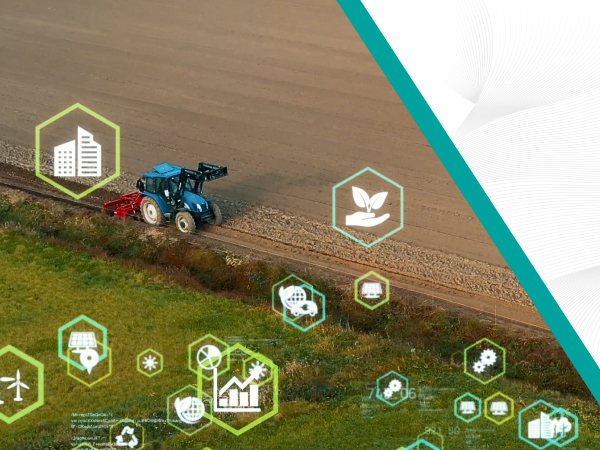Keep an Eye Out: New Trends in the AG Industry 2023 is rolling to an end, but industry advancements and changes remain …


Over the last several years, more businesses and industries have been focusing on developing more sustainable production and distribution models. The USDA released the Agriculture Innovation Strategy following the outline provided in their Agriculture Innovation Agenda, to push for better solutions and more efficient agricultural production across the value chain. The initiatives focus on research and development, implementing better production strategies, and aligning the private and public sectors to make these solutions applicable and available. These areas aim to improve production and market with solutions such as Genome Design, Automation and Digitalization, Prescriptive Intervention, and System-Based Farm Management.
Precision Farming and Regenerative Agriculture are two concepts that have been driving the development of today’s agritech. Monitoring tools are becoming more accessible and easier to implement, while also providing results with less environmental impact and better yield. This evolving market directly affects the economy, not only for farmers themselves but for the entire production chain, including the introduction of new job positions and skills required to continue improving and developing these solutions.
Most new tools revolve around automation, IoT, and decision-making, providing accurate measurements and inputs later fed to complex databases. Using this information, farmers can optimize their processes based on specific parameters, all localized to their land, equipment, and crop varieties. This specificity allows for more efficient process management as well as a more cost-effective, sustainable production.
Irrigation management
The agricultural industry accounts for about 80% of consumptive water usage in the US; therefore, optimizing irrigation methodologies and tools become critical to ensure everyone has access to water.
Whether it is a drip, sprinkler, gravity, micro water-delivery method, improving the water ratio can avoid crop loss. Precision Farming methods based on accurate soil readings and data hubs are pushing investment to fund new equipment ranging from electric and propane-based pumps, smart sprinklers, and monitoring apps to remote metering and ground sensors. Innovative technology can provide real-time information about the moisture levels present on a determined plantation radius and inform the user of imbalances or leaks that requires attention. This establishes more effective irrigation schedules and water distribution.
Nutrient Distribution
Fertilizers are a vital part of agricultural production, containing, among several nutrients, three main components: phosphorous, potassium, and nitrogen. Either naturally sourced or artificially designed, fertilizers provide the basics to keep soil nutrition balanced.
Establishing the proper fertilizer schedule can be a delicate task. Excess nutrients can significantly alter the soil composition, damaging and hindering the adequate growth cycle by reducing root system development and killing beneficial microorganisms. Some of this excess can also drain into bodies of water, polluting and altering ecosystems of reservoirs, rivers, and lakes. Fortunately, new innovations are tackling these issues, with a regenerative approach to agriculture and soil preservation, mixed with improved management tools.
Aerial views provided by drones and satellite multispectral imagery allow farmers to get accurate soil descriptions depending on geographical location. Interconnected software and decision-making IoTs offer general information and suggestions to optimize not only the application of fertilizer, but also estimate costs, labor, and other expenses to generate efficient plans and containment strategies. Hardware such as pH and chlorophyll meters, soil testing kits, sensors, and GPS-based grid sampling allow farmers to conduct a more thorough analysis of their crop sites before, during, and after harvest season. Drones can be mounted with specific sensors to maintain a clear vision of plant and terrain state; additionally, some have been specifically designed or fitted to spray fertilizer in a localized and precise manner, five times faster than traditional methods.
Tank Monitoring
Motored equipment requires just as much care and attention as the field. Diesel-based vehicles are significant players in the agricultural industry, taking part in the entire production process, including distribution.
The quality of the products used, from the diesel itself to the lubricants and oils necessary for its maintenance, also plays a significant role in reducing emissions and increasing efficiency, power, and lifespan of the equipment. Premium quality products designed by VISCOSITY Oil have better overall performance and offer the required protection needed by vehicles that demand higher horsepower and stricter maintenance schedules.
Formulations aside, hardware solutions are consistently becoming common practice for many farmers across the country. Although automation and robotics are evolving the market, some simple add-ins can make a difference in daily equipment operations. GPS, data transferring systems, and dynamic interfaces that can be visualized remotely for direct feedback, control, and assessment are some of the innovative gadgets found in new tractors’ designs. Additionally, unique complements such as tank monitoring sensors are now available to improve fluid usage and performance.
The industry continues to move forward and evolve, with more complex and detailed solutions— and stricter policies to improve efficiency and production quality. The future of agriculture will continue to become smarter as technology adapts and changes to accommodate the new demands in quality and sustainability the ever-growing population requires today. VISCOSITY Oil has the trusted technology and know-how to provide our community with the proper resources to keep work in fluid motion.
RELATED ARTICLES
Harvesting Success: Crop Rotation and Cover Crops Crop rotation and the use of cover crops are key tools for sustainable farming practices …

